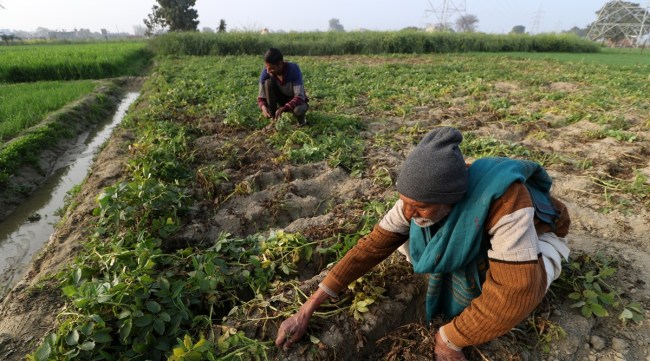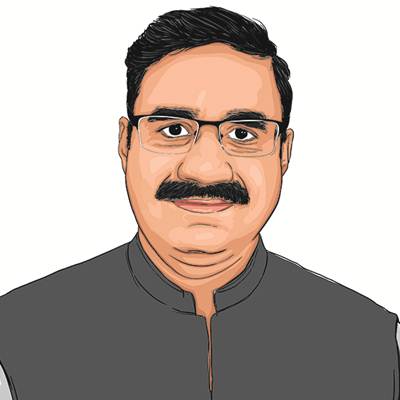Opinion Support given to farmers is an incentive to produce, not a subsidy or freebie
The so-called 'heavy farm subsidisation' is a case of 'heavy reverse subsidisation' of consumers by farmers. The cost of growing food, however high, has to be borne by the state for basic survival of people
 All input subsidies are actually consumer subsidies and not farmer subsidies as they are commonly called. Any other support to the farmers can at best be called an incentive to keep growing food for billions of people, not a subsidy or a freebie. (Express photo by Vishal Srivastav)
All input subsidies are actually consumer subsidies and not farmer subsidies as they are commonly called. Any other support to the farmers can at best be called an incentive to keep growing food for billions of people, not a subsidy or a freebie. (Express photo by Vishal Srivastav) In an article in this newspaper (‘Revisiting a dream‘, IE, March 6), Ashok Gulati argued that the Narendra Modi government gives a lot of subsidies to the farmers. He claimed that the farm subsidies given by the states and the Centre add up to more than Rs 4 lakh crore per annum. Many people in the country seem to believe that the farmers are the most pampered lot. Gulati says that the policy of heavy subsidisation of input subsidies, especially fertilisers and power, must be rationalised.
Let’s critically examine the issue. Gulati says that the fertiliser subsidy crosses Rs 2 lakh crore annually. The revised estimates (RE) for 2022-23 show that the fertiliser subsidy is indeed Rs 2.25 lakh crore. But this sharp spike was due to the geopolitical situation resulting from the Russia-Ukraine war; it was less than Rs 1 lakh crore a few years ago. The prices of fertilisers have now fallen substantially and this is reflected in the budget estimates of Rs 1.75 lakh crore for 2023-24.
The government fixes the minimum support price (MSP) for various crops on the basis of the recommendations of the Commission for Agricultural Costs and Prices (CACP). The Commission calculates the cost of production for various crops on the basis of the subsidised cost of fertilisers or other inputs and not at the actual cost of these inputs. Thus it reduces the cost of production by the value of the “input subsidy” given for that crop. The government then fixes a lower MSP for the crop based on the lower cost calculated by the CACP. So subsidised inputs ultimately reduce crop prices that the farmers get and thus, benefit the consumers. If, for instance, the cost of production (C) is Rs 1,000/quintal and there is no subsidy, an MSP of Rs 1,500/quintal as MSP would mean a 50 per cent profit. The CACP fixes the MSP at I.5 times the C. But if the input subsidy (S) is Rs 200/quintal, the CACP factors this in. It, therefore, takes Rs 800/quintal (C-S) for the purpose of fixing the MSP. At 1.5 times (C-S), the MSP is fixed at Rs 1200/quintal. This calculation has the effect of reducing the MSP by Rs 300/quintal or 1.5 times the amount of subsidy S. So, the subsidy is passed on to the consumer without any benefit to the farmers. In fact, the farmer loses 0.5 times of S or Rs 100/quintal. Thus, the fertiliser subsidy of Rs 2 lakh crore actually becomes a Rs 3-lakh crore subsidy for the consumers – in other words, Rs 1 lakh crore that should have gone to the farmer is reaped by the consumer.
What would happen if there’s no subsidy on inputs? The price of crops would increase proportionally for the consumers because the CACP and farmers would pass on the increased input costs to the consumers. Thus, all input subsidies — be it fertilisers or power — are basically consumer subsidies masquerading as farmer subsidies. And, the poor farmers don’t even know that. If the government wants to actually give input subsidies, it should give inputs at subsidised prices but calculate the cost of production at actual prices. The subsidy will then actually go to the farmers.
Gulati also writes that many people get a free ration of 5kg/person/month. This scheme benefits more than 80 crore people from rural and urban areas, not just farmers. Agreed, a part of the food subsidy does flow to poor farmers. Similarly, the crop insurance budget estimate (BE) for 2023-24 is Rs 13,625 crore. But, industries and companies are regularly given land by the government at throwaway prices to encourage investments. Nobody calls it a subsidy. Free ration is given to ensure the food security of the poor and mitigate malnutrition. Crop insurance compensates poor farmers for damaged crops so that they don’t fall into a debt trap. These are the social obligations of a welfare state, not a subsidy.
The PM-Kisan has a BE of Rs 60,000 crore which is directly transferred to around 10 crore farmer families; each family gets a paltry sum of Rs 6,000 per annum. The government gives the manufacturing industries cash doles in the name of production-linked incentive (PLI) schemes. Similarly, PM-KISAN should be classified as a PLI scheme for farmers.
Farmers are also given cheap credit up to Rs 3 lakh under an interest subvention scheme for short-term crop loans for the purchase of crop inputs. This has a budget estimate of Rs 23,000 crore in 2023-24. In 2019, the government reduced corporate taxes from 30 per cent to 22 per cent hoping that the companies would increase investments, which never happened. The government incurred a revenue loss of Rs 1.84 lakh crores in 2019-20 and 2020-21, as per a report by the parliamentary committee on estimates. The figure keeps increasing every year. The cheap credit given to the farmers is used by them for investments in farm production. So, these schemes can at best be classified as incentives to cater to the country’s food security.
Banks have written off loans amounting to about Rs 10-lakh crore loans, mostly to corporates. But a few thousand rupees to a farmer is described as “heavy subsidisation”. Gulati has himself co-led an OECD study about which he has written in an article (‘What the farmer is owed,’ IE, January 21, 2019) where he says “the Indian farmers have been implicitly taxed through restrictive marketing and trade policies that have an in-built consumer bias of controlling agri-prices.” Gulati argues that due to this, Indian farmers have lost Rs 45 lakh crore during 2000-2017.
In another article in this newspaper (‘A race to atone for the neglect of the farmer,’ IE, February 19, 2019,), he has written “China supported its farmers to the tune of $232 billion and the OECD countries by $235 billion in 2016-17 alone. No wonder China produces more than triple of India’s agri-output from a lesser cropped area.”
The so-called “heavy farm subsidisation” is in fact “heavy reverse subsidisation” of consumers. Any nation would take all the necessary measures for the food security of its people – this is also essential for national security. Let’s not forget that millions have died in our country and elsewhere in the world during famines. Countries have historically paid heavy costs for food shortages. The cost of growing food, however high, has to be borne by all countries for basic survival of their people. All input subsidies are actually consumer subsidies and not farmer subsidies as they are commonly called. Any other support to the farmers can at best be called an incentive to keep growing food for billions of people, not a subsidy or a freebie.
The writer is President, Kisan Shakti Sangh and an alumnus of the Institute of Rural Management, Anand






